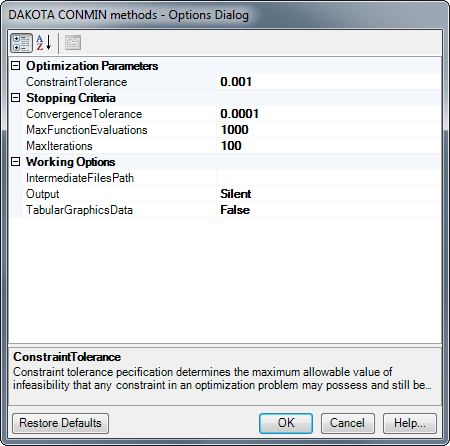DAKOTA CONMIN Algorithm
Description
CONMIN is a gradient based optimizer that uses the method of feasible direction to solve constrained problems. CONMIN was a predecessor to the DOT optimizer.
References
DAKOTA Version 5.0 Reference Manual

Control Parameters
ConstraintTolerance: Determines the maximum allowable value of infeasibility that any constraint in an optimization problem may possess and still be considered to be satisfied. Value must be greater than zero for all cases.
ConvergenceTolerance: The convergence tolerance specification provides a real value for controlling the termination of iteration. This option defines the threshold value on relative change in the objective function that indicates convergence for the problem. Value must be greater than zero for all cases.
MaxFunctionEvaluations: Function evaluation is the call to Analyzer to evaluate the objective function at the specified points. The maximum number of function evaluations is an integer limit for evaluations that the algorithm can attain. Algorithm can terminate with this criterion if no other criteria are satisfied. A single iteration can contain multiple function evaluations. MaxFunctionEvaluations must be a positive integer value.
MaxIterations: A single iteration will have multiple offset evaluations. This is the integer limit on number of iterations the algorithm can actually run. Option must have a positive integer value.
IntermediateFilesPath: User can specify the location where the intermediate files of optimization should be generated. By default files are written to the user's temporary directory.
Output: This option controls the level of verbosity of messages user can receive from DAKOTA. The options go from Silent to Debug with increasing amount of messages returned from the infrastructure. View Output > Details should show the messages from DAKOTA infrastructure.
TabularGraphicsData: Turning this option to true generates a file named dakota_tabular in IntermediateFilesPath directory. This file has the values of design variables, constraints and objective function for each evaluation stored in a tabular format.